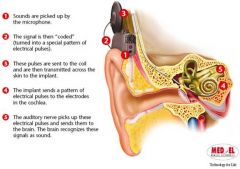![]()
![]()
![]()
Use LEFT and RIGHT arrow keys to navigate between flashcards;
Use UP and DOWN arrow keys to flip the card;
H to show hint;
A reads text to speech;
17 Cards in this Set
- Front
- Back
|
How Do CIs Work?
|

|
|
|
How Does a Cochlear Implant Work?
|
The CI consists of an ear-level or body-worn speech processor, with a battery source and a surgically implanted internal receiver stimulator attached to the electrode array that is placed in the cochlea.
|
|
|
Cochlear Implants
|
The processor which consists of a microphone, speech processor, and transmitter coil is either body worn or at the ear, similar to a BTE hearing aid.
|
|
|
Transmitter coil has a magnet that adheres to the
|
that adheres to the head over the skin where the receiver stimulator is placed. The microphone picks up the sound wave, converts it into an electrical signal, and sends it to the speech processor
|
|
|
speech processor codes the information using a device-specific strategy and sends it to
|
and sends it to the external transmitter coil. The coil sends the information through the skin via FM radio waves to an internal receiver
|
|
|
The Internal Receiver sends the information to
|
sends the information to the implanted electrodes that stimulate the available auditory nerve fibers
|
|
|
Cochlear Implants
|
The newest implants are very small
|
|
|
History of Cochlear Implants
|
In 1972 the first wearable implant was implanted in an adult at the House Ear Institute. The House/3M device consisted of a single electrode placed in the basal end of the cochlea. Over a 1000 persons received this device, in 1980 it became available for children over the age of 2 years.
|
|
|
In the 1980s multi-electrode devices
|
bringing more but still limited frequency cues. Many people were able to achieve open-set speech understanding
|
|
|
Many improvements came in the 1990s, demonstrating over
|
demonstrating over 80% scores in open-set in auditory-only conditions
|
|
|
Currently, there are three (3) companies that are approved by the FDA. They are
|
They are Cochlear, Advanced Bionics (swimming), and Med-El (MRI are feasible).
|
|
|
The Cochlear Implant Team
|
A multidisciplinary team is necessary for a successful cochlear implant program.
The Team leaders are the Otolaryngologist and Audiologist |
|
|
The Team includes:
|
Otolaryngologist: Surgery and medical decisions
Audiologist: Determines audiologic candidacy and programs the processor Speech Language Pathologist Teachers of the hearing impaired Social Workers Parents |
|
|
Who Is a Candidate?
|
Not everyone is a candidate. Sometimes the HINT test is done as well.
Candidacy differs with insurance companies. |
|
|
The current criterion for adults is
|
is < 50% speech recognition in the ear to be implanted when listening at normal levels to sentences on the HINT test in the best aided conditions. The opposite ear must have < 60%.
|
|
|
The current criterion for children is
|
is bilaterally profound sensorineural hearing loss > 90 dB in 12 to 24-month-olds and > 70 dB in 24 month-olds to 18-year-olds with limited benefit from traditional amplification.
|
|
|
Formal evaluations should include
|
include standard audiometric unaided test batteries, Otoacoustic emissions, aided speech perception testing and aided speehreading evaluations.
Otologic-medical evaluations done by a physician include MRIs or CT scans to determine if patient is implantable. There should be no medical contraindications, VII nerve absence or active middle ear infections. |

